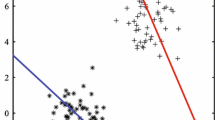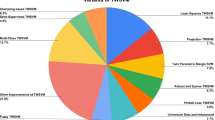Abstract
In this paper, we propose two efficient approaches of twin support vector machines (TWSVM). The first approach is to reformulate the TWSVM formulation by introducing \(L_1\) and \(L_\infty \) norms in the objective functions, and convert into linear programming problems termed as LTWSVM for binary classification. The second approach is to solve the primal TWSVM, and convert into completely unconstrained minimization problem. Since the objective function is convex, piecewise quadratic but not twice differentiable, we present an efficient algorithm using the generalized Newton’s method termed as GTWSVM. Computational comparisons of the proposed LTWSVM and GTWSVM on synthetic and several real-world benchmark datasets exhibits significantly better performance with remarkably less computational time in comparison to relevant baseline methods.









Similar content being viewed by others
References
Alon U, Barkai N, Notterman DA, Gish K, Ybarra S, Mack D, Levine AJ (1999) Broad patterns of gene expression revealed by clustering analysis of tumor and normal colon tissues probed by oligonucleotide arrays. Proc Natl Acad Sci 96:6745–6750
Arabasadi Z, Alizadehsani R, Roshanzamir M, Moosaei H, Yarifard AA (2017) Computer aided decision making for heart disease detection using hybrid neural network-genetic algorithm. Comput Methods Prog Biomed 141:19–26
Armijo L (1996) Minimization of functions having lipschitz continuous first partial derivatives. Pacific J Math 16:1–3
Bazaraa MS, Sherali HD, Shetty CM (2013) Nonlinear programming: theory and algorithms. Wiley, Hoboken
Bazikar F, Ketabchi S, Moosaei H (2020) Dc programming and dca for parametric-margin \(\nu \)-support vector machine. Appl Intell 50:1–12
Burges CJ (1998) A tutorial on support vector machines for pattern recognition. Data Min Knowl Discov 2:121–167
Cao L (2003) Support vector machines experts for time series forecasting. Neurocomputing 51:321–339
Clarke F (1990) Optimization and Nonsmooth Analysis, Society for Industrial and Aplied Mathematics
Cortes C, Vapnik V (1995) Support-vector networks. Mach Learn 20:273–297
Deng N, Tian Y, Zhang C (2012) Support vector machines: optimization based theory, algorithms, and extensions. CRC Press, Boca Raton
Déniz O, Castrillon M, Hernández M (2003) Face recognition using independent component analysis and support vector machines. Pattern Recogn Lett 24:2153–2157
Ding S, Shi S, Jia W (2019) Research on fingerprint classification based on twin support vector machine. IET Image Process 14:231–235
Ding S, Zhang N, Zhang X, Wu F (2017) Twin support vector machine: theory, algorithm and applications. Neural Comput Appl 28:3119–3130
Dua D, Graff C (2019) Uci machine learning repository, 2017, http://archive.ics.uci.edu/ml, 37
Fung GM, Mangasarian OL (2005) Multicategory proximal support vector machine classifiers. Mach Learn 59:77–97
Georgiev PG, Theis FJ (2009) Optimization techniques for date representions with biomedical applications. In: Handbook of optimization in medicine, Springer, pp 1–38
Guyon I, Weston J, Barnhill S, Vapnik V (2002) Gene selection for cancer classification using support vector machines. Mach Learn 46:389–422
Hiriart-Urruty JB, Strodiot JJ, Nguyen VH (1984) Generalized hessian matrix and second-order optimality conditions for problems withc 1, 1 data. Appl Math Optim 11:43–56
Hong ZQ, Yang JY (1991) Optimal discriminant plane for a small number of samples and design method of classifier on the plane. Pattern Recogn 24:317–324
Khemchandani Jayadeva R, Chandra S (2007) Twin support vector machines for pattern classification. IEEE Trans Pattern Anal Mach Intell 29:905–910
Joachims T (1999) Making large-scale svm learning practical. advances in kernel methods-support vector learning, http://svmlight.joachims.org/
Ketabchi S, Moosaei H (2012) Minimum norm solution to the absolute value equation in the convex case. J Optim Theory Appl 154:1080–1087
Ketabchi S, Moosaei H, Razzaghi M, Pardalos PM (2019) An improvement on parametric \(\nu \) -support vector algorithm for classification. Ann Oper Res 276:155–168
Khemchandani R, Saigal P, Chandra S (2016) Improvements on \(\nu \)-twin support vector machine. Neural Netw 79:97–107
Mangasarian OL (1994) Nonlinear programming, SIAM
Mangasarian OL (2002) A finite newton method for classification. Optim Methods Softw 17:913–929
Mangasarian OL, Musicant DR (2001) Lagrangian support vector machines. J Mach Learn Res 1:161–177
Mangasarian OL, Wild EW (2001) Proximal support vector machine classifiers. In: Proceedings KDD-2001: knowledge discovery and data mining, Citeseer
Mangasarian OL, Wild EW (2005) Multisurface proximal support vector machine classification via generalized eigenvalues. IEEE Trans Pattern Anal Mach Intell 28:69–74
Mangasarian OL, Wild EW (2006) Multisurface proximal support vector machine classification via generalized eigenvalues. IEEE Trans Pattern Anal Mach Intell 28:69–74
Molina GNG, Ebrahimi T, Vesin JM (2003) Joint time-frequency-space classification of eeg in a brain-computer interface application. EURASIP J Adv Signal Process 2003:253269
Moosaei H, Musicant D, Khosravi S, Hladík M (2020) MC-NDC: multi-class normally distributed clustered datasets. Carleton College, University of Bojnord. https://github.com/dmusican/ndc
Musicant D (1998) NDC: normally distributed clustered datasets
Noble WS et al (2004) Support vector machine applications in computational biology. Kernel Methods Comput Biol 71:92
Pardalos PM, Ketabchi S, Moosaei H (2014) Minimum norm solution to the positive semidefinite linear complementarity problem. Optimization 63:359–369
Peng X (2010) A \(\nu \)-twin support vector machine (\(\nu \)-tsvm) classifier and its geometric algorithms. Inf Sci 180:3863–3875
Platt J (1999) Fast training of svms using sequential minimal optimization, advances in kernel methods-support vector learning
Richhariya B, Tanveer M (2018) Eeg signal classification using universum support vector machine. Exp Syste Appl 106:169–182
Richhariya B, Tanveer M, Rashid A, Initiative ADN et al (2020) Diagnosis of alzheimer’s disease using universum support vector machine based recursive feature elimination (usvm-rfe). Biomed Signal Process Control 59:101903
Ripley B (1996) Pattern recognition and neural networks datasets collection
Shao YH, Zhang CH, Wang XB, Deng NY (2011) Improvements on twin support vector machines. IEEE Trans Neural Netw 22:962–968
Tanveer M, Khan MA, Ho SS (2016) Robust energy-based least squares twin support vector machines. Appl Intell 45:174–186
Tanveer M, Richhariya B, Khan R, Rashid A, Khanna P, Prasad M, Lin C (2020) Machine learning techniques for the diagnosis of alzheimer’s disease: a review. ACM Trans Multimedia Comput Commun Appl (TOMM) 16:1–35
Tian Y, Qi Z (2004) Review on: twin support vector machines. Ann Data Sci 1:253–277
Trafalis TB, Ince H (2000) Support vector machine for regression and applications to financial forecasting. In: Proceedings of the IEEE-INNS-ENNS international joint conference on neural networks. IJCNN 2000. Neural Computing: New Challenges and Perspectives for the New Millennium, vol 6, IEEE, pp 348–353
Valentini G, Muselli M, Ruffino F (2004) Cancer recognition with bagged ensembles of support vector machines. Neurocomputing 56:461–466
Vapnik V (2013) The nature of statistical learning theory. Springer, Berlin
Vapnik VN, Chervonenkis AJ (1974) Theory of pattern recognition. Nauka, Moscow
Vn V (1998) Statistical learning theory. Wiley, New York
Zhang Z, Ding S, Sun Y (2020) A support vector regression model hybridized with chaotic krill herd algorithm and empirical mode decomposition for regression task. Neurocomputing 410:185–201
Author information
Authors and Affiliations
Corresponding author
Ethics declarations
Conflict of interest
The authors have no conflict of interests to declare.
Additional information
Publisher's Note
Springer Nature remains neutral with regard to jurisdictional claims in published maps and institutional affiliations.
Rights and permissions
About this article
Cite this article
Moosaei, H., Ketabchi, S., Razzaghi, M. et al. Generalized Twin Support Vector Machines. Neural Process Lett 53, 1545–1564 (2021). https://doi.org/10.1007/s11063-021-10464-3
Accepted:
Published:
Issue Date:
DOI: https://doi.org/10.1007/s11063-021-10464-3
Keywords
- Support vector machines
- Twin support vector machines
- Linear programming
- Unconstrained minimization problem
- Generalized Newton-Armijo method




